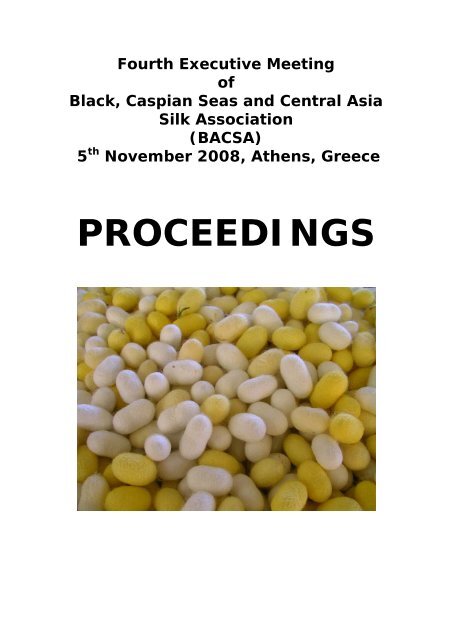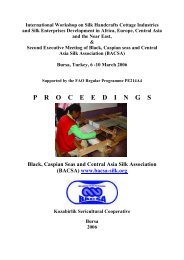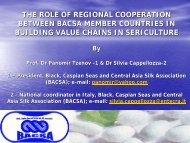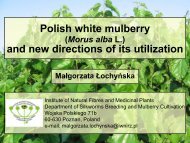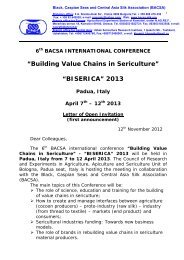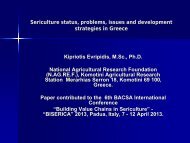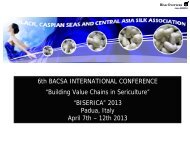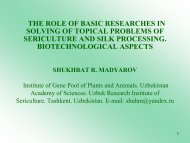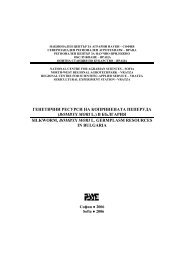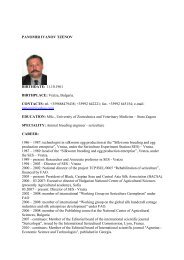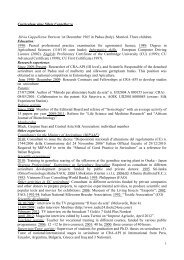The BACSA 4th executive meeting, November 2008, Athens, Greece
The BACSA 4th executive meeting, November 2008, Athens, Greece
The BACSA 4th executive meeting, November 2008, Athens, Greece
Create successful ePaper yourself
Turn your PDF publications into a flip-book with our unique Google optimized e-Paper software.
Fourth Executive Meeting<br />
of<br />
Black, Caspian Seas and Central Asia<br />
Silk Association<br />
(<strong>BACSA</strong>)<br />
5 th <strong>November</strong> <strong>2008</strong>, <strong>Athens</strong>, <strong>Greece</strong><br />
PROCEEDINGS
Fourth Executive Meeting<br />
of<br />
Black, Caspian Seas and Central Asia Silk Association<br />
(<strong>BACSA</strong>)<br />
5 th <strong>November</strong> <strong>2008</strong>, <strong>Athens</strong>, <strong>Greece</strong><br />
PROGRAMME<br />
1. Opening – Dr P. Tzenov, <strong>BACSA</strong> president<br />
2. New strategies for the regional sericulture development – by Dr<br />
P. Tzenov and Dr E. Kipriotis<br />
3. Reports of the <strong>BACSA</strong> national coordinators about sericulture<br />
status and the strategies for development in each country. – by<br />
the <strong>BACSA</strong> national coordinators in each country<br />
4. Panel discussion on the above topics.<br />
5. Panel discussion on how to participate in the EU 7 framework<br />
programme.<br />
6. <strong>BACSA</strong> organizational.<br />
th
Final document<br />
of the 4 th <strong>BACSA</strong> <strong>meeting</strong>, held on 5 th <strong>November</strong> <strong>2008</strong> at <strong>Athens</strong>,<br />
<strong>Greece</strong> during the 21 st Congress of the International Sericultural<br />
Commission<br />
<strong>The</strong> <strong>BACSA</strong> <strong>executive</strong> committee in the forum: “Fourth Executive<br />
Meeting of Black, Caspian Seas and Central Asia Silk Association<br />
(<strong>BACSA</strong>)”, 5 th <strong>November</strong> <strong>2008</strong>, <strong>Athens</strong>, <strong>Greece</strong> took the following<br />
decisions and planned follow ups:<br />
1. Express formal gratefulness to the Government of <strong>Greece</strong> and<br />
personally to Dr E. Kipriotis – <strong>BACSA</strong> vice – president and national<br />
coordinator in <strong>Greece</strong> for organizing the 4 th <strong>BACSA</strong> <strong>meeting</strong>.<br />
2. <strong>The</strong> <strong>BACSA</strong>’ national coordinators to inform their governments about<br />
the 4 th <strong>BACSA</strong> <strong>executive</strong> <strong>meeting</strong> results and decisions.<br />
Term: December <strong>2008</strong><br />
Responsible persons: <strong>The</strong> <strong>BACSA</strong> national coordinators<br />
3. To prepare and upload at the <strong>BACSA</strong> web site the Proceedings of the<br />
4 th <strong>BACSA</strong> <strong>meeting</strong>, decisions and follow ups<br />
Term: December <strong>2008</strong><br />
Responsible person: Dr P. Tzenov<br />
4. To make efforts in re-starting the evaluation by the FAO of the<br />
<strong>BACSA</strong> regional TCP project proposal “Improvement and Revival of<br />
Sericulture Industries in Eastern Europe and Central Asia”.<br />
Term: <strong>November</strong> <strong>2008</strong><br />
Responsible person: Dr P. Tzenov<br />
5. To submit to FAO a proposal about support to regional sericulture<br />
germpleasm maintenance, evaluation, exchange and utilization.<br />
Term: <strong>November</strong> <strong>2008</strong><br />
Responsible persons: Dr P. Tzenov, Dr H. Z. Lea & Dr S. Cappellozza<br />
6. To nominate a new <strong>BACSA</strong> national coordinator for Ukraine.<br />
Term: December <strong>2008</strong><br />
Responsible persons: Dr P. Tzenov and the Executive committee<br />
members<br />
7. To replace some of the not efficient <strong>BACSA</strong> Executive members with<br />
new persons.<br />
Term: December <strong>2008</strong><br />
Responsible persons: Dr P. Tzenov and the Executive committee<br />
members
8. To make efforts in strengthening the possible technical and scientific<br />
cooperation among the <strong>BACSA</strong> and other countries through the<br />
European framework programmes. <strong>The</strong> EU member countries<br />
(Bulgaria, <strong>Greece</strong> and Romania) and candidates (Turkey) should be<br />
especially active in searching for foreign partners and initiation of<br />
joint research projects and cooperation.<br />
Term: permanent<br />
Responsible persons: All the Executive committee members<br />
9. Recommends to Dr E. Kipriotis – <strong>BACSA</strong> National coordinator in<br />
<strong>Greece</strong> to initiate actions in the Greek government, targeting to the<br />
adaptation of the existing legislative frames for the control,<br />
production, provision and circulation of silkworm and mulberry<br />
genetic material to the recently created situation in sericulture.<br />
Term: January 2009<br />
Responsible person: Dr E. Kipriotis<br />
10. Recommends to the <strong>BACSA</strong> national coordinator in Iran, Dr<br />
Etebary to initiate actions in the Iranian government, targeting to<br />
provide more financial support to the sericulture farmers.<br />
Term: January 2009<br />
Responsible person: Dr K. Etebary<br />
11. <strong>BACSA</strong> Executive committee recommends to the Bulgarian<br />
Sericulture Association to continue making efforts the government of<br />
Bulgaria to start implementation after 2009 of the EUROPEAN<br />
COUNCIL REGULATION (EC) No 1544/2006 of 5 October 2006 laying<br />
down special measures to encourage silkworm rearing and the<br />
COMMISSION REGULATION (EC) No 1744/2006 of 24 <strong>November</strong><br />
2006 on detailed rules for aid in respect of silkworms. For year 2009<br />
to suggest to the government of Bulgaria providing national financial<br />
direct support to the silkworm reareres.<br />
Term: permanent<br />
Responsible persons: Mr. S. Beshkov, Dr D. Grekov, Dr P. Tzenov<br />
12. To conduct the next 5 th <strong>BACSA</strong> <strong>meeting</strong> in September or<br />
October 2009 while the place and the theme of the international<br />
<strong>meeting</strong> will be decided in the early 2009.<br />
Responsible persons: <strong>BACSA</strong> Executive committee members<br />
13. <strong>The</strong> <strong>BACSA</strong> national coordinators and the Executive committee<br />
members to make efforts in organizing national/regional <strong>meeting</strong>s<br />
or conferences on the occasion of the International year of natural<br />
fibers 2009.<br />
Responsible persons: <strong>BACSA</strong> Executive committee members<br />
14. All the new ideas and proposals for the <strong>BACSA</strong><br />
activities/projects to be sent by the Executive committee members
to the <strong>BACSA</strong> president who is obliged to reply to them/all the<br />
<strong>executive</strong> committee members within maximum 15 days after<br />
receiving the proposal.<br />
Responsible persons: <strong>BACSA</strong> Executive committee members & the<br />
President
Introduction<br />
<strong>The</strong> preconditions and prospects for<br />
sericulture revival and development in the<br />
Black, Caspian seas and Central Asia (<strong>BACSA</strong>)<br />
region are the very long tradition and<br />
experience in sericulture, availability of rich<br />
mulberry tree resources, favorable climatic<br />
conditions, governmental support to the<br />
sector, the increasing demand within the<br />
European countries for natural and biological<br />
products along with the close huge European<br />
silk market etc.
<strong>The</strong> recent constraints, facing the sericulture<br />
industry development in the region may be divided<br />
as common for all the countries and specific for<br />
each the European and Central Asian countries. <strong>The</strong><br />
main common problems for all the region are too<br />
low raw silk quality produced presently, resulting in<br />
fail to receive the standard price in the markets and<br />
to loose existing markets and that the production<br />
technologies at the field level are still more relying<br />
on the traditional technology and management<br />
system thus not to be commercially oriented<br />
operation.
On the other hand as a main barrier in<br />
the East European countries for their<br />
sericulture development is that presently<br />
the too low raw silk prices at the<br />
international market can not stimulate<br />
the farmers to produce cocoons without<br />
additional support from the government.
By the same time in most of the<br />
Central Asian countries the quality of<br />
presently available silkworm eggs do<br />
not meet the international standard<br />
and their quantity can not satisfy the<br />
local needs. For example in the<br />
recent years Tajikistan imports about<br />
90 % and Uzbekistan - 60 % of the<br />
necessary silkworm eggs.
One of the basic aims of expansion of the inter –<br />
regional cooperation is therefore to transmit the<br />
richer sericulture germplasms and advanced<br />
technologies from the West to the East and<br />
simultaneously the East European countries to<br />
play a role as a bridge for opening the European<br />
silk market to the silk products both from<br />
Eastern Europe and Central Asia.
Reasons for the decline of cocoon and silk<br />
production in the <strong>BACSA</strong> region<br />
<strong>The</strong> major reasons are:<br />
• <strong>The</strong> transitional period from centralized to market<br />
economic system which lead to sudden stop of the<br />
governmental support to sericulture, breakage of the<br />
traditional economic relationships between the countries<br />
thus the destroy of the already established system for<br />
sharing the different parts of sericultural production.
•<strong>The</strong> raw silk price at the international market<br />
has been dictated by China and only few<br />
other low income countries could withstand<br />
the competition without state subsidies for<br />
the cocoon producers.
•<strong>The</strong> appearance of new, competitive with the silk<br />
synthetic fibres and their huge distribution in the<br />
international market.<br />
•<strong>The</strong> instability of cocoon and silk prices s particularly<br />
within the local markets.
<strong>The</strong> rapid urbanization due to heavy<br />
industrialization, especially in Eastern Europe.<br />
•<strong>The</strong> gain of new crops, especially industrial ones,<br />
which provided higher incomes and lead to the<br />
replacement of the mulberry plantations.
•Reduction and/or limitation of<br />
international economic growth rate which<br />
encourages utilization of cheaper<br />
products.
<strong>The</strong> disadvantages and advantages of the <strong>BACSA</strong> region<br />
countries for their sericulture revival and development<br />
As the main disadvantages for sericulture development may<br />
be identified:<br />
•<strong>The</strong> impossibility to compete without state support with<br />
China and other developing countries with respect to the<br />
cocoon/raw silk productional costs.<br />
•<strong>The</strong> impossibility to compete with Italy and France in silk<br />
fabrics and commodities printing and design.
<strong>The</strong> disadvantages and advantages of the <strong>BACSA</strong><br />
region countries for their sericulture revival and<br />
development<br />
<strong>The</strong> main advantages are:<br />
•Availability of comparatively rich mulberry and silkworm<br />
genetic resources, well developed science and technology<br />
in sericulture. In 2006 and 2007 <strong>BACSA</strong> organized in 4<br />
countries simultaneously an international testing of 15 F1<br />
silkworm hybrids, originated from 10 different countries<br />
which proved that after the Japanese hybrid some of the<br />
local hybrids from Bulgaria, Ukraine, Turkey, Azerbaijan,<br />
Romania and Uzbekistan manifested the highest silk<br />
productivity.
<strong>The</strong> disadvantages and advantages of the <strong>BACSA</strong><br />
region countries for their sericulture revival and<br />
development<br />
•<strong>The</strong> possible scientific cooperation among the <strong>BACSA</strong><br />
and other countries through the European framework<br />
programmes.
<strong>The</strong> disadvantages and advantages of the <strong>BACSA</strong> region<br />
countries for their sericulture revival and development<br />
•<strong>The</strong> strong state support to sericulture in some of the<br />
region countries: Recently most of the region countries<br />
gradually solved the economical problems, caused by the<br />
transition from a centralized to a free market system, thus<br />
the governments increased their support to the silk industry.<br />
<strong>The</strong> silkworms<br />
rearing activity within the European Union<br />
(EU) countries such as Bulgaria, <strong>Greece</strong> and Romania is<br />
considered as one of the protected and promoted agro-<br />
industry. <strong>The</strong> European commission conducts a protective<br />
policy for sericulture development by providing a direct<br />
subsidy in amount of EUR 133.26 for each silkworm egg box<br />
reared. From the European subsidy plus the cocoon<br />
purchasing price for only 3 months work it may be obtained<br />
an annual income by rearing 10 boxes of silkworm eggs in<br />
amount of around EUR 3000 which puts the sericulture into<br />
the most profitable agricultural crops.
• Sericulture development projects are supported by EU<br />
funds through the following measures of the Rural<br />
Development Program for the period 2007 – 2013:<br />
•Professional training, informational activities and scientific<br />
knowledge dissemination.<br />
•Establishment of farms by young farmers.<br />
•Modernizing the agricultural farms.<br />
•Value adding to agricultural and forestry products.<br />
•Semi-subsistence farms.
• Direct financial support to the sericulture<br />
farmers in amount of US$ 8-9/kg 8<br />
fresh cocoons<br />
is provided by the Turkish government.<br />
Considering the state subsidies to sericulture in<br />
some of the region countries, it may be<br />
concluded that their cocoons/raw silk produced<br />
are quite competitive at the market.<br />
Recently some of the biggest silk producers in the<br />
region such as Tajikistan and Uzbekistan attracted<br />
some foreign investors in their silk industry.<br />
<strong>The</strong> local silk market in the region is in a process of<br />
development following the gradual increase of the<br />
people’s s living standard.<br />
<strong>The</strong> still available unique silk handcrafts production<br />
is also an important factor.
<strong>The</strong> solutions for future sericulture industries<br />
development<br />
<strong>The</strong> <strong>BACSA</strong> region countries should use their unique<br />
advantages in sericulture development by means of<br />
product diversification. <strong>The</strong> main directions of the<br />
regional strategy for sericultural industries revival and<br />
development may be:<br />
•Development of new sericultural products such as use<br />
the mulberry and silkworm for non – silk purposes.<br />
Utilization the rich germplasm and advanced science<br />
for development of new varieties, breeds and hybrids<br />
suitable for these aims.
WHICH ARE THE MAJOR CONSTRAINTS AGAINST<br />
AND RECOMMENDATIONS FOR PROMOTION OF<br />
USING THE SERICULTURE PRODUCTS FOR NON –<br />
TEXTILE PURPOSES IN THE <strong>BACSA</strong> COUNTRIES?<br />
•Lack of tradition and experience in the scientifically<br />
based processing the waste and by – products from<br />
sericulture;<br />
•Not sufficient research made on the subject;<br />
•Lack of enough industrial technologies for sericulture<br />
products non-textile<br />
processing;
•<strong>The</strong> present European system for giving subsidies to the<br />
sericultural farmers requires producing obligatory not less<br />
than 20 kg of fresh cocoons from one box of eggs. In the<br />
case that the farmers sell for example silkworm larvae<br />
instead of cocoons they can not get any EU subsidy.<br />
<strong>The</strong>refore there should be found some other criteria to prove<br />
the amount of silkworms reared and the EU regulations for<br />
the subsidies to be changed in order to stimulate not only the<br />
cocoon production but the other products from sericulture as<br />
well.
•<strong>The</strong> mulberry and silkworm breeding priorities may be redirected<br />
in order to meet the requirements of the products<br />
use for non – textile purposes. For example some new<br />
mulberry varieties with high fruit yield and quality or<br />
varieties with faster growth and accumulation of quality wood<br />
for the furniture industry may be created.<br />
In the silkworm new strains having bigger larvae and pupae<br />
or with higher sericin content or tolerable to artificial diet<br />
feeding or breeds with some specific quantitative traits may<br />
be evolved.
MAJOR CONSTRAINTS AGAINST AND<br />
RECOMMENDATIONS FOR PROMOTION OF USING THE<br />
SERICULTURE PRODUCTS FOR NON –TEXTILE<br />
PURPOSES IN THE <strong>BACSA</strong> COUNTRIES<br />
•It is also important to develop a technology for production and supply<br />
with high quality silkworm eggs all over the year.<br />
•It is necessary that the mulberry agrotechnics and harvesting systems<br />
and the silkworm rearing technologies to correspond with those new non<br />
– textile purposes product use.
MAJOR CONSTRAINTS AGAINST AND<br />
RECOMMENDATIONS FOR PROMOTION OF USING<br />
THE SERICULTURE PRODUCTS FOR NON –TEXTILE<br />
PURPOSES IN THE BALKAN COUNTRIES<br />
• <strong>The</strong> silkworms use for non textile items requires in many cases to t<br />
grow them all over the year, therefore the <strong>BACSA</strong> countries have to<br />
develop the silkworm artificial diet rearing system.
•It is expected that production costs in the <strong>BACSA</strong> region will increase<br />
while more countries with lower labour costs will join the sericulture<br />
production. <strong>The</strong>refore, it is challenged to the region producers to compete<br />
in the world markets. In order to survive in sericulture business,<br />
producers should not make cheap products with low quality to compete<br />
for the prices but to produce more sophisticated products which satisfy<br />
consumers even though they are more expensive.
<strong>The</strong> strategy of the <strong>BACSA</strong> region sericulture products<br />
processing industries should be to produce our own unique<br />
products which are definitely different from other countries.<br />
It is important to encouragee<br />
the sericulture products<br />
processing companies to establish global relationships, such<br />
as international joint ventures and cooperative deals in the<br />
field of research and technology licensing.
•Considering the rich sericulture germplasm in Europe, an<br />
European mulberry and silkworm genetic resources<br />
preservation center may be established in one of the member<br />
states through the EU financial support programmes. . <strong>The</strong><br />
main tasks of this center could be preservation of all<br />
mulberry and silkworm varieties available in the member<br />
states in parallel with the countries of their origin,<br />
development of innovative techniques for the germplasm<br />
preservation, supply of the member states with genetic<br />
material for research purposes etc.
•<strong>The</strong> <strong>BACSA</strong> countries may be established as sources of<br />
sericultural genetic resources for the developing<br />
countries which may be paid by the respective donor<br />
organizations.
<strong>The</strong> solutions for future sericulture industries<br />
development<br />
•Production in bi and multilateral cooperation mulberry sapling of highly<br />
productive varieties and high quality silkworm eggs for <strong>meeting</strong> the local<br />
needs and for export as well.
<strong>The</strong> solutions for future sericulture industries<br />
development<br />
•Production of very high quality bivoltine silk with certain<br />
special characteristics. As per the advice of Mr. E. Seitz, a<br />
long-term silk textile expert if the <strong>BACSA</strong> countries are able<br />
to offer grey silk woven fabrics, mostly “Creep De Chine”, 60<br />
m without fault, alternatively in 90 cm and 150 cm width they<br />
could be highly competitive. Since the <strong>BACSA</strong> region is<br />
within or nearby EU if these fabrics are produced on stock<br />
the <strong>BACSA</strong> countries would have the advantage to deliver<br />
them within days to Italy and France. With modern automatic<br />
machines, wages would not play a major role. <strong>The</strong> looms<br />
would weave the same product all over the year, no change in<br />
yarn count, no change in the loom, no change of quality, thus<br />
such plant would be extremely competitive.
•Silk handcraft production for<br />
selling to the tourists at the local<br />
market and also for export.
<strong>The</strong> <strong>BACSA</strong> region countries could offer the following fields for<br />
cooperation and business partnership with the R & D institutions<br />
and the silk industry from other countries:<br />
•Supply with high quality P1 and F1 bivoltine silkworm<br />
eggs;<br />
•Making exchange of mulberry varieties and silkworm<br />
hybrids;<br />
•Participation in joint research projects, financed by the<br />
EU and/or other donors;<br />
•Short/medium term training courses of trainees from<br />
<strong>BACSA</strong> region in other countries and vice versa;<br />
•Conducting bachelor, magisterial and PhD training<br />
courses of foreign students in some <strong>BACSA</strong> countries;<br />
•Establishment of joint venture companies for<br />
production of raw silk, fabrics and garment;<br />
•Establishment of joint trading companies for sell of silk<br />
products in Europe.
Conclusions and recommendations<br />
As a final conclusion may be summarized that we have all<br />
the preconditions for a future sericulture development in the<br />
<strong>BACSA</strong> region. It is of a crucial importance to modernize the<br />
silkworm rearing at the field level and to improve the cocoon<br />
and silk quality, to provide stable state or EU financial<br />
support to the sericulture, to enhance the regional scientific<br />
cooperation through participation in the EU 7th framework<br />
programme.
Conclusions and recommendations<br />
<strong>The</strong> sericulture product diversification is very important in<br />
order to stabilize the industry and to survive during the crisis<br />
situations. This diversification requires the development of<br />
sericulture products non – textile use and to produce our<br />
own more sophisticated and unique products.
Conclusions and recommendations<br />
An European mulberry and silkworm genetic resources<br />
preservation center may be established in one of the member<br />
states through the EU financial support programmes. It is<br />
necessary to encourage the bi and multilateral cooperation<br />
especially in the mulberry sapling and silkworm eggs<br />
production and trade.
Thank you for<br />
your attention
1<br />
RECENT SERICULTURE STATUS IN BULGARIA AND TRENDS FOR<br />
DEVELOPMENT<br />
By Dr Dimitar Grekov<br />
<strong>BACSA</strong> national coordinator in Bulgaria<br />
Paper presented in the 4 th <strong>BACSA</strong> <strong>meeting</strong><br />
<strong>November</strong> 5, <strong>2008</strong> <strong>Athens</strong>, <strong>Greece</strong><br />
Dear ladies and gentlemen, colleagues,<br />
<strong>The</strong> sericulture industry development in Bulgaria now has the following<br />
three main components, namely:<br />
- New possibilities for the sericulture support from European Union<br />
funds;<br />
- New achievements of the sericultural science and technology;<br />
- <strong>The</strong> private business activities;<br />
1. <strong>The</strong> support from the EU funds<br />
Before joining to the EU the Bulgarian Government signed a 3 – year<br />
agreement to pay direct European subsidies to the agricultural producers<br />
only per unit land (ha). However this system for giving direct subsidies<br />
benefited mostly the farmers who produce cereals. For example the<br />
animal breeders receive very limited support through this system. It’s<br />
same for the sericulture – the payment per one ha of mulberry plantation<br />
is about 100 EUR, while if the subsidy is released per silkworm egg box<br />
reared the farmer could obtain about 4000 EUR from one ha mulberry<br />
plantation as subsidy. Unfortunately until the end of the next year the<br />
direct subsidy system will remain the same.<br />
<strong>The</strong> sericulture farmers expected to get this good European subsidy<br />
since the beginning of 2007 so most of them became very much<br />
disappointed and the planned increase of the cocoon production in<br />
Bulgaria had not been realized.<br />
<strong>The</strong> Sericulture Experiment Station, Vratza and the Bulgarian<br />
sericulture association raised many times this problem at the Ministry of<br />
Agriculture and Food, the Prime – Minister’s office, the Parliament etc. An<br />
official enquiry to the European commission about this problem was sent<br />
by the Bulgarian Government. However the response of the European<br />
commission was that until the end of 2009 Bulgaria can not implement<br />
any direct payment per silkworm egg box reared.<br />
Now the Bulgarian Government knows the problem and we have their<br />
assurances that in the next agreement with the EU the subsidy system for<br />
the sericulture per box of eggs will be considered.
2<br />
Since the beginning of this year in Bulgaria has started the Program<br />
for rural areas development which has different measures for supporting<br />
the long term – investments in agriculture sector.<br />
Sericulture development projects will be supported by EU funds<br />
through the following measures of the Rural Development Program for the<br />
period 2007 – 2013:<br />
• Professional training, informational activities and scientific<br />
knowledge dissemination.<br />
• Establishment of farms by young farmers.<br />
• Modernizing the agricultural farms.<br />
• Value adding to agricultural and forestry products.<br />
• Semi-subsistence farms.<br />
Considering the very good EU direct subsidy per silkworm egg box<br />
reared, which is expected to come after 2009 now many agricultural<br />
producers are interested to apply for funding through the above EU<br />
programmes.<br />
So it could be said that at present the capital investments in sericulture<br />
are provided by the EU Rural Development Program and the direct support<br />
to the cocoon price will be provided after 2009. <strong>The</strong>se two factors are a<br />
sound basis for the future sericulture industry development in Bulgaria.<br />
2. <strong>The</strong> new achievements of the sericultural science and<br />
technology<br />
In the last two years at the SES – Vratza and Agricultural University,<br />
Plovdiv were created the following new scientific products:<br />
- one new four – way sex – limited for larval markings silkworm hybrid,<br />
having higher tolerance to adverse rearing conditions;<br />
- one new silkworm hybrid having silk yield comparable with those of the<br />
Japanese hybrid Shunrei x Shogetsu;<br />
- technology for production of high quality silkworm eggs, suitable for<br />
rearing all over the year;<br />
- two new sex – limited for cocoon color silkworm breeds and one<br />
commercial hybrid;<br />
<strong>The</strong> above scientific achievements will contribute for increase of the<br />
competitiveness of the Bulgarian silkworm eggs, cocoons and raw silk.<br />
3. <strong>The</strong> private business activities<br />
A private Joint Stock company, named “Bulgarian silk” was<br />
registered in May 2005 in Sofia. This company has as main target<br />
activities the realization of a national project for sericulture revival and<br />
development and increase the cocoon and silk production in Bulgaria in<br />
order to reach production of about 3.5 million meters of silk fabrics around<br />
2010-2012. For a short time the company prepared a business plan and<br />
made contacts with Bulgarian and foreign commercial banks for getting<br />
loans for project funding. Unfortunately their efforts in providing funding<br />
for their project still do not have any evident results. <strong>The</strong> global<br />
economical crisis had also its contribution.
3<br />
By the same time “Bulgarian silk” company made a lot of efforts to<br />
prepare the necessary conditions for the start of project. <strong>The</strong> company<br />
identified 72 potential mulberry sapling producers, with a total capacity of<br />
10 million sapling during the next five years. <strong>The</strong> producers were trained<br />
at SES-Vratza. <strong>The</strong> company developed business plans of several bigger<br />
companies which are going to plant around 1000 ha mulberry plantations.<br />
<strong>The</strong> company plans to buy the necessary cocoon drying machines<br />
and to import from China fully automatic silk reeling machines.<br />
By the same time in this year a new association of the cocoon and<br />
silk producers in North Bulgaria was established in the city of Russe and<br />
based on the silk weaving factory Danubian silk. This association has very<br />
serious intentions in increasing the cocoon production in the next years in<br />
order to satisfy the capacity of silk weaving factory with high quality raw<br />
silk.<br />
<strong>The</strong>re’s also a private silk weaving company in Sofia who buys raw<br />
silk from the SES – Vratza and produces mostly boutique small series of<br />
silk fabrics by orders from fashion designers.<br />
<strong>The</strong> private business activities in Bulgaria are recently directed not<br />
only in silk production, but also in the use of sericultural products for non<br />
– textile purposes. For example new mulberry plantations were created by<br />
two companies for production of mulberry fruits, leaves for tea making<br />
and for high quality wood to be used in the furniture industry.<br />
We expect after 2009 a gradual increase of cocoon and silk<br />
production in Bulgaria.
4<br />
Sericulture in <strong>Greece</strong> of <strong>2008</strong><br />
Problems – Aspects – Prospects<br />
Paper presented in the 4 th <strong>BACSA</strong> <strong>meeting</strong><br />
<strong>November</strong> 5, <strong>2008</strong> <strong>Athens</strong>, <strong>Greece</strong><br />
Kipriotis Evripidis, M.Sc., Ph.D.<br />
National Agricultural Research Foundation (N.AG.RE.F.), Komotini Agricultural Research<br />
Station<br />
Merarhias Serron 18, Komotini 69 100, <strong>Greece</strong><br />
In the last two years silkworm rearing in <strong>Greece</strong>, in contrast to previous predictions<br />
and expectations, showed a slide decline, both by means of silkworm egg boxes<br />
reared and cocoons produced nationally. <strong>The</strong> number of involved farmers remained<br />
approximately at the same levels as in the last five years, although some new<br />
farmers had entered the sector, but the reared silkworm egg boxes declined to a total<br />
number of 5.000 boxes in year <strong>2008</strong>. <strong>The</strong> only promising point out of the so formed<br />
situation is that the new entered to the sector silkworm farmers had invested to new<br />
modern rearing installations including egg incubation and hatching facilities as well<br />
as their own cocoon cooking installations. <strong>The</strong>se new installations have come out<br />
through specific programs funded be the EU and targeting to the reorganization and<br />
the improvement of already operating farm units.<br />
As it was mentioned previously silkworm rearing in <strong>Greece</strong> showed a slide decline in<br />
the last two years, in contrast to previous predictions and expectations which came<br />
out of the strong support provided to sericulture by the EU funds, both in rearing and<br />
mulberry field installation. <strong>The</strong> so developed situation definitely reflects some<br />
nationally existing problems and complications around sericulture which affect the<br />
sector and derive from the following facts:<br />
• <strong>The</strong> legislative frame which controls the full process of silkworm egg<br />
production, examination, control, importation and distribution exists since 1918<br />
and is completely old-fashioned and insufficient.<br />
• <strong>The</strong>re had not been developed a national strategy for the sector of sericulture,<br />
concerning promotion, research, training, evaluation and use of national<br />
silkworm and mulberry resources, and general care for this so important by<br />
means of income sector.<br />
• Greek sericulture is up-to-date completely depended upon imported silkworm<br />
eggs through a Public Tender announced every year by the Ministry of<br />
Agriculture. Through this process there can be imported every year silkworm<br />
eggs of different origin and quality, since there are put very loose and brief<br />
specifications and recommendations, not coming out of previous testing and<br />
evaluation procedures. This in many cases drives to the purchase and<br />
distribution of eggs not corresponding to the specific rearing conditions of each<br />
Greek area, since from south to north of the country there are existing extreme<br />
climatic and rearing conditions.<br />
• Apart of that there interferes always a huge degree of burrocracy in the whole<br />
process of egg provision, which in many times guides to delays catastrophic<br />
for the rearing, putting it out of the suitable season.<br />
• <strong>The</strong> same situation is met in the provision of mulberry saplings for the<br />
installation of new mulberry fields, which again is faced in the same way, by
5<br />
occasional imports from several directions, without any previous testing and<br />
evaluation concerning the adaptation to the different Greek regions, the<br />
productivity and the leaf quality. This situation caused to some farmers serious<br />
problems with their newly installed mulberry fields, especially by means of cold<br />
damages due to very early sprouting of imported, without any testing, mulberry<br />
varieties.<br />
As it was mentioned, the absolute cause of the above situation is the lack of a<br />
national system controlling the registration of silkworm genetic material, by means of<br />
local or imported breeds, lines and hybrids, and also the lack of specific law for the<br />
approval and circulation of local and imported silkworm genetic material in a national<br />
level, something which should only be done through previous testing and evaluation<br />
of the any silkworm genetic material, for its adaptation and suitability to the specific<br />
climatic and rearing conditions of the various Greek regions.<br />
<strong>The</strong> same system should be applied to the registration and circulation of mulberry<br />
genetic material for Selicultural purposes, taking in consideration the adaptation and<br />
suitability of any local or imported material to the specific climatic and rearing<br />
conditions of the various Greek regions.<br />
As the top of all the above described problems and complications comes the lack of<br />
national reeling facilities, something which creates many difficulties in the cocoon<br />
disposal and selling. <strong>The</strong>re is an almost complete lack of local trade for this product<br />
and many of the produced cocoons are not directed to any market or sold to several<br />
occasional directions, under not realistic prices and through processes not beneficial<br />
to the farmers, something which guides to serious income losses.<br />
Through all the above described facts the out - coming conclusions are:<br />
• <strong>The</strong> Greek sericulture has an interesting potential and many prospects for<br />
development, deriving from the high EU support, both to rearing and mulberry<br />
field installation.<br />
• Under the existing legislative frames for the control, production, provision and<br />
circulation of silkworm and mulberry genetic material, there are created to the<br />
farmers many and serious problems, causing serious losses to their<br />
sericultural income.<br />
• <strong>The</strong> development of local reeling facilities and cocoon trade structures is<br />
considered as very important and able to add serious increase to the farmer’s<br />
income, and this matter should be faced urgently and efficiently by the Greek<br />
authorities.<br />
• <strong>The</strong> final conclusion is that there are existing interesting prospects for the<br />
Greek sericulture, able to increase the sector and the farmer’s income,<br />
contribute to the replacement of declining agricultural activities – as the<br />
tobacco cultivation- and also contribute to the problems of unemployment and<br />
rural development.<br />
• <strong>The</strong> affecting the Greek sericulture problems can be efficiently controlled by<br />
few simple actions, targeting to the adaptation of the legislative frame to the<br />
recently created situation in sericulture, the sector’s modern demands and the<br />
support of the development of a national cocoon reeling and trade frame.
An Overview on the Situation of Sericulture in Iran<br />
Seyed Hossein Hosseini Moghaddam<br />
Animal Science Department, Agriculture Faculty, University of Guilan, Rasht, Iran<br />
Correspondence email address: hosseini@guilan.ac.ir / hosseinim2001@yahoo.com<br />
Abstract<br />
Several years ago production of cocoon and silk reached to maximum level during last<br />
century, but sharp decrease of sericulture and silk industry happened within few years<br />
ago. Whereas Iran is the seventh producer of cocoon and silk in the world, it has been<br />
appeared as a silk and cocoon import country. Approximately one – third of the silkworm<br />
raisers plan to reduce the volume of their sericulture activities and half of them remain to<br />
want the continuation of the silkworm rearing. <strong>The</strong> aim of this report is to supply the<br />
quantitative and qualitative situation and potential future of sericulture in Iran.<br />
Silkworm Raisers Viewpoint<br />
In order to study of sericulture problems and the viewpoints of the silkworm raisers in<br />
Iran a research was conducted in the entire silkworm raising provinces. 737<br />
questionnaires were distributed based upon their share to buy the silkworm egg. <strong>The</strong><br />
samples were selected randomly and systematically.<br />
While 12% of the silkworm raisers were lower than 30 years old, 47% of them were<br />
30 to 50 years old and 41% were higher than 50 years old. Of those who have been<br />
questioned, 93% of them have had the silkworm raisers’ parents and 72% of them have<br />
raised the silkworm beyond ten times. <strong>The</strong> silkworm raiser expressed various reasons to<br />
do this occupation. <strong>The</strong> 30% of them continued this occupation because of their<br />
ancestors’ profession, 28% of them set forth to do that because of being in a situation to<br />
need the money severely, 26% of them told the reason to do that profession as interested<br />
in that, 11% of them brought up being free while rearing the silkworm, 4% of them said<br />
the good income and 1% of them the more cases to do that task as a reason. One of the<br />
interesting points of this view – measuring is the time to earn the income. 86% of the<br />
them recognized this time being very on time and this time was not of particular<br />
importance just for 10% of them (4% of the questionnaires were not to be answered). Of<br />
the total individuals who are asked, 36% of them believe that the production of the fresh<br />
cocoon compared to the other agricultural activities, including animal husbandry, rice<br />
planting, tea planting, gardening and etc, is not saving economically and 53% of them<br />
believe that the production of the cocoon compared to the other activity is to some extent<br />
saving economically, only, 9% of it was known being much saving economically by them.<br />
According to quantity of silkworm rearing this work is a minor job for farmers and only 3<br />
percent of raisers earn adequate money by this activity.<br />
<strong>The</strong> problems of the raisers while rearing suggest that most of them have difficulties<br />
not associated with the quality of the silkworm egg and the silkworm; but lack of<br />
information regarding the principles of silkworm rearing in addition to the usage of the<br />
traditional rearing places. However, numbers of the individuals, which have set forth the<br />
problem of the silkworm diseases, are numerous and it shows that there exists this<br />
problem yet, in sprite of performing efforts to produce the resistance silkworm varieties.<br />
<strong>The</strong>refore more silkworm breeding program need to be conducted. Furthermore, this<br />
study clarified that the most important reasons for not buying silkworm egg are the low
price of the cocoon and the others, including the lack of attachment, the inferior quality<br />
of the silkworm egg and the silkworm or lack of the land or the require facilities to rear<br />
are not very important to be posed. <strong>The</strong> reason for the attachment to sericulture is the<br />
traditional nature of the activities of these families so that they suppose this occupation as<br />
the continuation of their ancestors’ activities, moreover, since the entire affaire and tasks<br />
are performed by the members of the family, the cost to produce the cocoon is to be<br />
reduced, that is, in case of the existence of the mulberry, the farming families intend to<br />
earn an income in the best possible times. As a result, there are tendency to silkworm<br />
rearing permanently beside the other farming activities.<br />
Current Situation<br />
With regard to the current price inflation in the country as well as the increased labor<br />
cost, the return of sericulture can provides very little amount of the living costs, and the<br />
farmers are not satisfied to the cocoon price. Furthermore in the Central Asian countries<br />
neighboring Iran, such as Ozbakistan and Afghanestan, which is not the consumer of the<br />
silk, it is produced with the price lower than it in Iran. Meanwhile, the cheaper foreign<br />
silk thread are available, therefore, silk price has not been increased significantly during<br />
past years in Iran, as a result, there is little incentive for silkworm rearing activity. <strong>The</strong><br />
lack of attachment, the inferior quality of the silkworm egg or lack of the land and the<br />
required facilities for silkworm rearing are all not very important reasons for the<br />
declining of sericulture in Iran. During few years ago the average fresh cocoon price was<br />
about 3 to 4 $. Due to these circumstances sharp decrease of sericulture and silk industry<br />
happened within few years ago and today Iran was appeared as a silk and cocoon import<br />
country.<br />
While 77000 boxes of silkworm egg sold in 2006, 50000 boxes was purchased by the<br />
Guilan’s farmers and thus, the share of the Guilan Province reached to 65%, while it was<br />
about 55% in the past. This means in spite of fluctuation of cocoon production Guilan<br />
province still play the major role in sericulture of Iran. Here the attachment of farmers to<br />
sericulture in some cities of Guilan province means farmers maintained this occupation as<br />
the continuation of their ancestors’ activities due to the traditional nature of the<br />
agricultural; moreover, since the entire affaire is performed by the family members, the<br />
cocoon production cost is minimized. <strong>The</strong> major agriculture activities in this region are<br />
rice, tea, and silkworm rearing, therefore, wherever there are exited mulberry trees, the<br />
farming families intend to earn more income by incorporating silkworm rearing.<br />
While the average of silk production during 20 years ago was 640T in <strong>2008</strong> just 180 T<br />
was produced. Approximately 400-500 ton reduction of the silk production in Iran during<br />
several years ago was not matched to the decrease of carpet production and exportation<br />
(Fig 1); this is because a part of the raw silk has been imported from abroad. Based upon<br />
the formal reports, 178 tons of silk has been imported to the country from April to<br />
September of 2006. <strong>The</strong>refore with regards to actual silk business it is unlikely that the<br />
silk production is affected by the rate of the carpet’s exportations.
M illion U S $<br />
800<br />
700<br />
600<br />
500<br />
400<br />
300<br />
200<br />
1996 1997 1998 1999 2000 2001 2002 2003 2004<br />
Fig.1 Handmade carpet exports from Iran<br />
<strong>The</strong> multiple and extensive programming, directed increasing the quality and quantity<br />
of the exporting carpets have been conducted during the recent years, which can maintain<br />
the full – glorified place of the Iranian carpet within next decades. Because of the<br />
noticeable demand to cocoon and silk in Iran for the production of the silk carpets, rugs<br />
and the silk handicrafts and also the attachment of farmers to produce cocoon in some<br />
cities of Guilan province, cocoon production and silk industry will be continued.
SERICULTURE IN TURKEY<br />
Presented By.<br />
Ayhan KARAGÖZOĞLU<br />
General Manager of Kozabirlik
Present Situation of Sericulture Sector in Turkey<br />
• Around half a million of families are involved in sericulture and silk<br />
production activities, and about 2,500 families in 276 villages of 24<br />
Provinces are engaged in cocoon production activities in upper land,<br />
where they do not have any alternative cash crops.<br />
• More than 80 percent of the<br />
cocoons produced in Turkey are<br />
processed into silk carpets, in which<br />
about 14 times of added value is<br />
created from fresh cocoons to silk<br />
carpet production. With annual<br />
export of 50-80 tonnes of silk<br />
carpets, the total earnings realised<br />
around US$ 25-35 million during<br />
1998-2002.
• Turkey has a huge potential for local silk market development, which still needs<br />
annually 200-250 tonnes of raw silk, equivalent to approximately 1,200 - 1,500<br />
tonnes of fresh cocoons. As a result of decrease in cocoon production since<br />
1990s, the country imported about 200 tonnes of raw silk in 2002 and 2003 to<br />
meet the domestic demand of silk carpet industries.<br />
• This is why the Government is providing a support for the sericulture<br />
sector by paying Direct Income Supporting Fee to the cocoon farmers,<br />
which resulted in higher cocoon price since 2002, stimulating the local<br />
cocoon production
• <strong>The</strong> sericulture technology to produce cocoons and raw silk<br />
still remains in traditional way, resulting in lower productivity<br />
and inferior quality of final silk products than in the other<br />
developed sericulture countries.
<strong>The</strong>re were two main organizations involved in sericulture industry<br />
up until July 2005: the Sericulture Research Institute (SRI) under<br />
the Ministry of Agriculture and Rural Affairs and Kozabirlik, the<br />
Union of Sericulture Cooperatives.<br />
<strong>The</strong> SRI was mainly<br />
engaged in research and<br />
extension work on<br />
sericulture while<br />
Kozabirlik’s mandate<br />
included:<br />
1) Maintenance of silkworm genetic resources and production of<br />
commercial silkworm eggs,<br />
2) Supply of silkworm eggs to farmers<br />
3) Extension service and training of sericulture farmers;<br />
4) Cocoon purchasing, marketing and market development.
Under a Government decree, the SRI has been<br />
merged into Kozabirlik as a research and training<br />
branch department since July 2005, enabling<br />
Kozabirlik to institutionally handle the entire sector<br />
of sericulture industries in the country.<br />
Kozabirlik is now composed of 23 staff and three technicians<br />
in the head office in Bursa and five district cooperatives of<br />
which the presidents elected by sericulture farmers in every<br />
district are the members of managing board, which makes<br />
policies and decisions for the operation. <strong>The</strong> organization is<br />
administrated by a general manager who is appointed by the<br />
managing board.
In order to revive our silk industry we are<br />
already implementing some new measures<br />
and policies. First of all Kozabirlik had<br />
decided to invest a new silk reeling factory<br />
which will start to run in December <strong>2008</strong>
In order to catch the international quality standarts for the Turkish origin<br />
silk yarn Kozabirlik also had taken some new measures for cocoon rearing.<br />
First of all with Kozabirlik’s application Turkey is now receiving one<br />
sericultural project from FAO.<br />
<strong>The</strong> project was approved in April <strong>2008</strong> and since May <strong>2008</strong> the facilities<br />
have been carried out. <strong>The</strong> project is aiming to strengthening production<br />
of silkworm eggs and raw silk in Turkey by providing modern equipments<br />
and materials and also technical assistance
Some measures and policies that we must take for<br />
increasing the quality of the fresh cocoons in<br />
summary:<br />
1) <strong>The</strong> mulberry trees used for silkworm rearing in most sericulture farmers<br />
in Turkey are very old with more than thirty years since planted. <strong>The</strong> old<br />
mulberry plants will be replaced by new trees with applying the pruning<br />
system at medium height and with proper fertilization of organic matters.<br />
Kozabirlik already started to distributing new mulberry sapplings to the<br />
farmers which already reached to amount of 170,000 pcs in the last two<br />
years.
2) Since there is only one commercial silkworm variety in<br />
the country, it is necessary to introduce new hybrid with<br />
resistance to diseases and high productivity. Under the<br />
project implementation Turkey will receive two pure races.
3) <strong>The</strong> larval duration and cocoon production vary with the sericulture<br />
farmers, due to mainly the temperature control and management<br />
during young silkworm stage (first to third instars). Rearing conditions<br />
of young silkworms at farmers’ level should be improved by introducing<br />
cooperative rearing system at each village. For this reason we already<br />
negotiating with the government to create some new funds for building<br />
new young silkworm rearing houses in some certain areas of the<br />
country.
4) <strong>The</strong> sericulture farmers who obtained poor cocoon production had<br />
improper rearing rooms without cleaning and control management<br />
of temperature and humidity. Silkworm rearing rooms of sericulture<br />
farms should be maintained in sanitary conditions by cleaning and<br />
disinfection. With the help of the FAO project we will set up five<br />
demonstration rearing rooms in five villages.
5) <strong>The</strong> cocoon farmers are using the bushes and tree branches as<br />
cocooning frames at the end of silkworm rearing, which induce irregular<br />
cocoons with marked cocoon shell. New mounting frames for cocoon<br />
spinning will be designed with uniform type manufactured by a mould<br />
for plastic to produce quality cocoons. <strong>The</strong> steel frame for plastic<br />
injection will be provided by the end of <strong>2008</strong>.


